The fallen blossom,
Rising back to its branch,
Is a butterfly.
Arakida Moritake
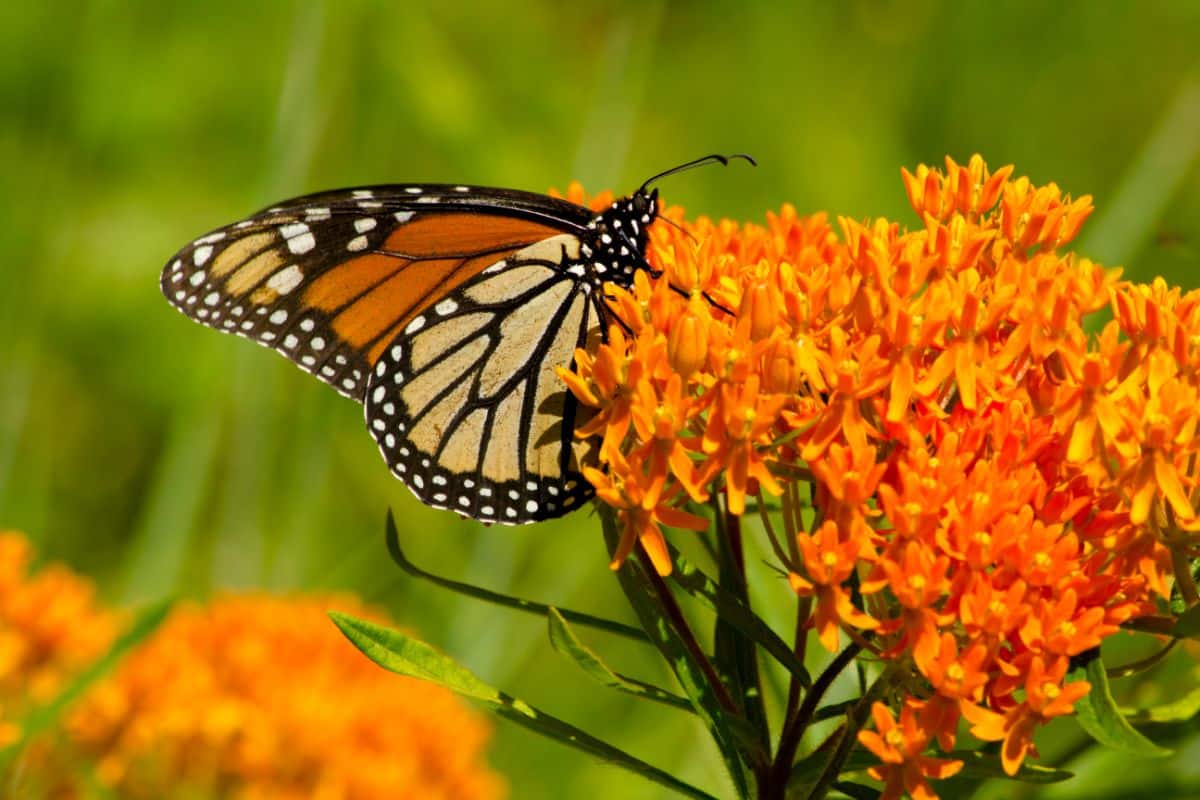
Monarch butterflies are always a welcome sight in the garden. Their bright wings resemble dappled spots of sunshine as they dart about the colorful flowers and gently catch on the summer breeze. They are also top pollinators that can boost the genetic diversity of plants and help to create a thriving garden.
However, migratory monarch butterflies are imperiled, and they were recently added to the endangered species list. This is partly due to habitat loss and fragmentation, which makes it difficult for monarchs to find their primary food source: milkweed. Milkweed is also an essential host plant for monarch caterpillars, which cannot develop without it.
Planting milkweed in your garden is one of the top ways individuals can help monarch butterflies make a comeback. But did you know in the United States alone, there are over 73 different species of native milkweed? With all that diversity, it can be difficult to decide which milkweed variety to plant!
In this guide, we’ve listed some of the top milkweed species to grow to help monarch butterflies.
Jump to:
- 16 types of milkweed to grow for monarch butterflies
- 1. Common Milkweed (Asclepias syriaca)
- 2. Swamp Milkweed (Asclepiasincarnata)
- 3. Butterflyweed (Asclepias tuberosa)
- 4. Showy Milkweed (Asclepias speciosa)
- 5. Whorled Milkweed (Asclepias verticillata)
- 6. Purple Milkweed (Asclepiaspurpurascens)
- 7. Antelope-Horns Milkweed(Asclepias asperula)
- 8. California Milkweed (Asclepias californica)
- 9. White Milkweed (Asclepias variegata)
- 10. Mexican Whorled Milkweed (Asclepias fascicularis)
- 11. Desert Milkweed (Asclepias erosa)
- 12. Poke Milkweed (Asclepias exaltata)
- 13. Green Milkweed (Asclepias viridis)
- 14. Aquatic Milkweed (Asclepias perennis)
- 15. Sandhill Milkweed (Asclepias humistrata)
- 16. Zizotes Milkweed (Asclepias oenotheroides)
- Other ways to help monarch butterflies
- Frequently asked questions
- Summary
16 types of milkweed to grow for monarch butterflies
Native milkweeds are the best choices for monarch butterflies since they’ve evolved alongside these butterflies and are perfectly suited to their needs. Below you’ll find some of the most common milkweed varieties, as well as growing details about them to help you pick the right milkweed for your garden.
1. Common Milkweed (Asclepias syriaca)
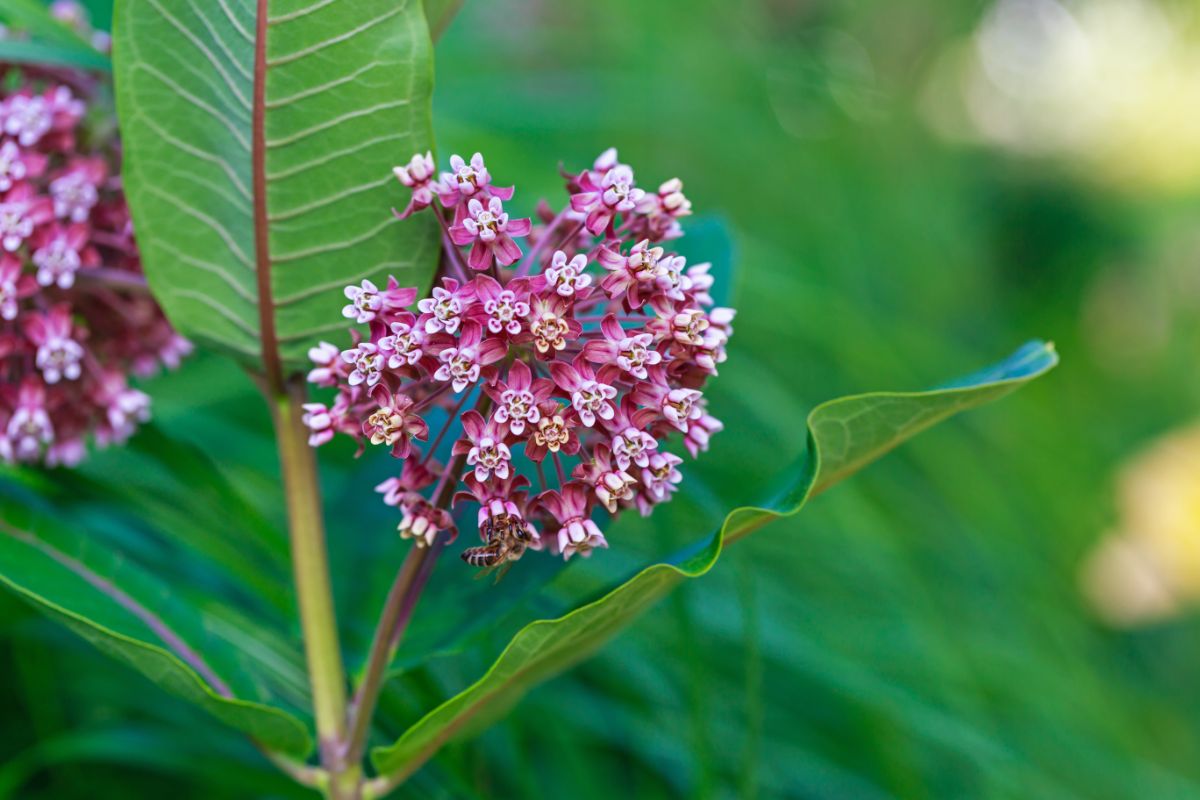
| Milkweed variety: | Common milkweed |
| Light requirements: | Full sun |
| Water requirements: | Low |
| Bloom time: | June to August |
| Growing zone: | Zones 3 to 9 |
Native to the eastern and central United States, common milkweed is a showy specimen with oversized, pinkish-purple blooms. Flowers appear from June to August and are highly fragrant, with hints of lilac. A top choice for pollinator habitats, common milkweed is much beloved by monarchs and other butterflies too.
Growing up to 6’ tall, common milkweed has a long tap root that can make it difficult to transplant. However, its root system also makes this species drought tolerant, and it can survive in climates as cool as zone 3. After blooming, common milkweed produces large seed pods that readily self-sow in the wind.
2. Swamp Milkweed (Asclepiasincarnata)
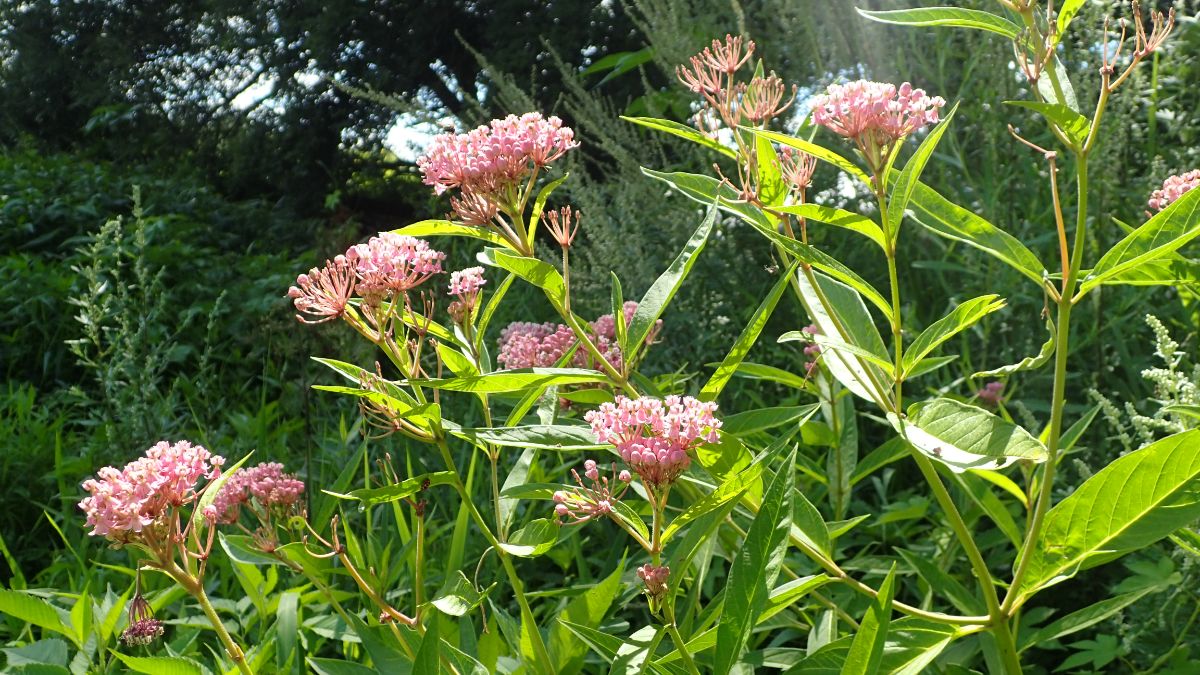
| Milkweed variety: | Swamp milkweed |
| Light requirements: | Full sun to part shade |
| Water requirements: | High |
| Bloom time: | Mid-summer to early fall |
| Growing zone: | Zones 3 to 9 |
Another cold hardy milkweed, swamp milkweed, grows throughout much of the United States and eastern Canada. Growing to about 5’ in height, swamp milkweed has narrower leaves than common milkweed, but it also blooms fragrant pink flowers. This plant has a denser and more bush-like growth habit, and it doesn’t tolerate drought well.
As its name suggests, swamp milkweed grows best in moist, rich soils. This plant will need regular watering, and it can be planted along pond margins or near other water features. In addition to monarch butterflies, swamp milkweed will attract queen butterflies and native bees to your garden.
3. Butterflyweed (Asclepias tuberosa)
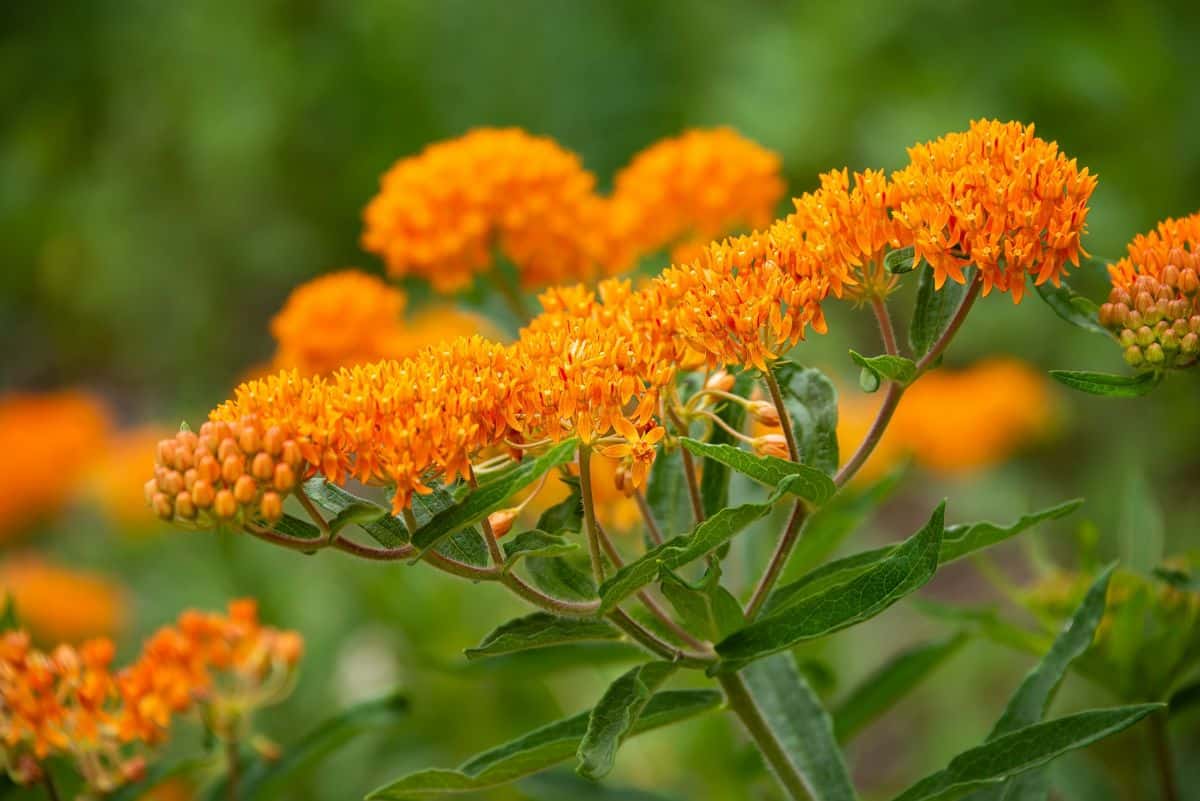
| Milkweed variety: | Butterflyweed |
| Light requirements: | Full sun |
| Water requirements: | Low |
| Bloom time: | June to August |
| Growing zone: | Zones 3 to 9 |
For showy, vivid blooms, butterflyweed is the milkweed variety of choice. This tropical-looking plant has bright orange flowers, although you can find naturally occurring yellow varieties too. One of the most important milkweed types for monarchs, butterflyweed is also a widespread species and can be found throughout most of the eastern United States.
Growing from 1 to 3’ tall, butterflyweed is not as large as some other milkweed varieties, but it still packs a punch in gardens. This plant is highly attractive to queen butterflies, gray hairstreak butterflies, and monarchs too. Once established, butterflyweed is relatively drought tolerant and has minimal watering needs.
4. Showy Milkweed (Asclepias speciosa)
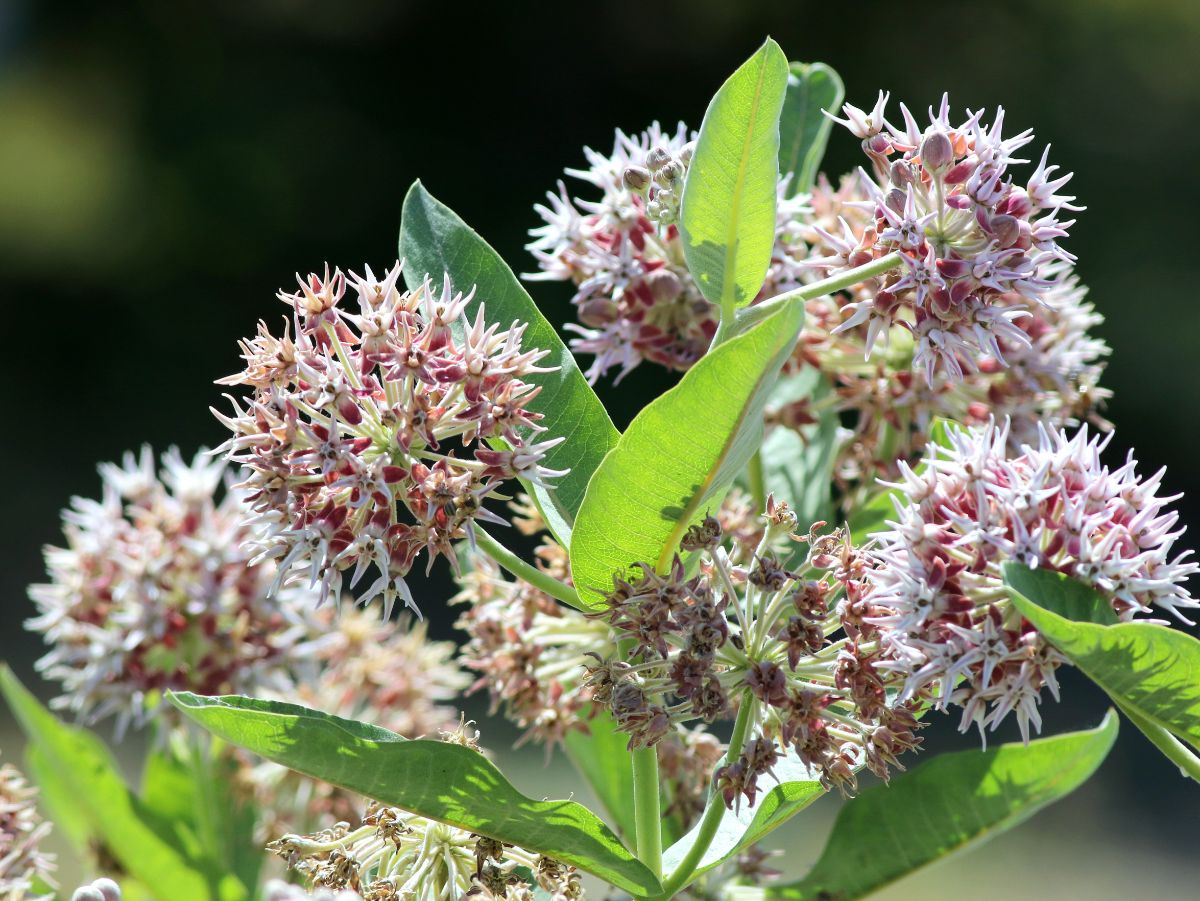
| Milkweed variety: | Showy milkweed |
| Light requirements: | Full sun |
| Water requirements: | Moderate to low |
| Bloom time: | May to September |
| Growing zone: | Zones 4 to 9 |
With a name like “showy milkweed,” this species promises a lot … and it delivers! Showy milkweed is definitely a stunning plant with large, pink, ball-shaped flowers that have a spiky appearance. Blooming in June and July, showy milkweed is bound to attract butterflies and native bees to your garden.
Native to the western United States, showy milkweed grows in zones 4 to 9. This plant requires full sun and well-draining soil, but it is otherwise very adaptable. It can even handle drought once it is established in your garden!
5. Whorled Milkweed (Asclepias verticillata)
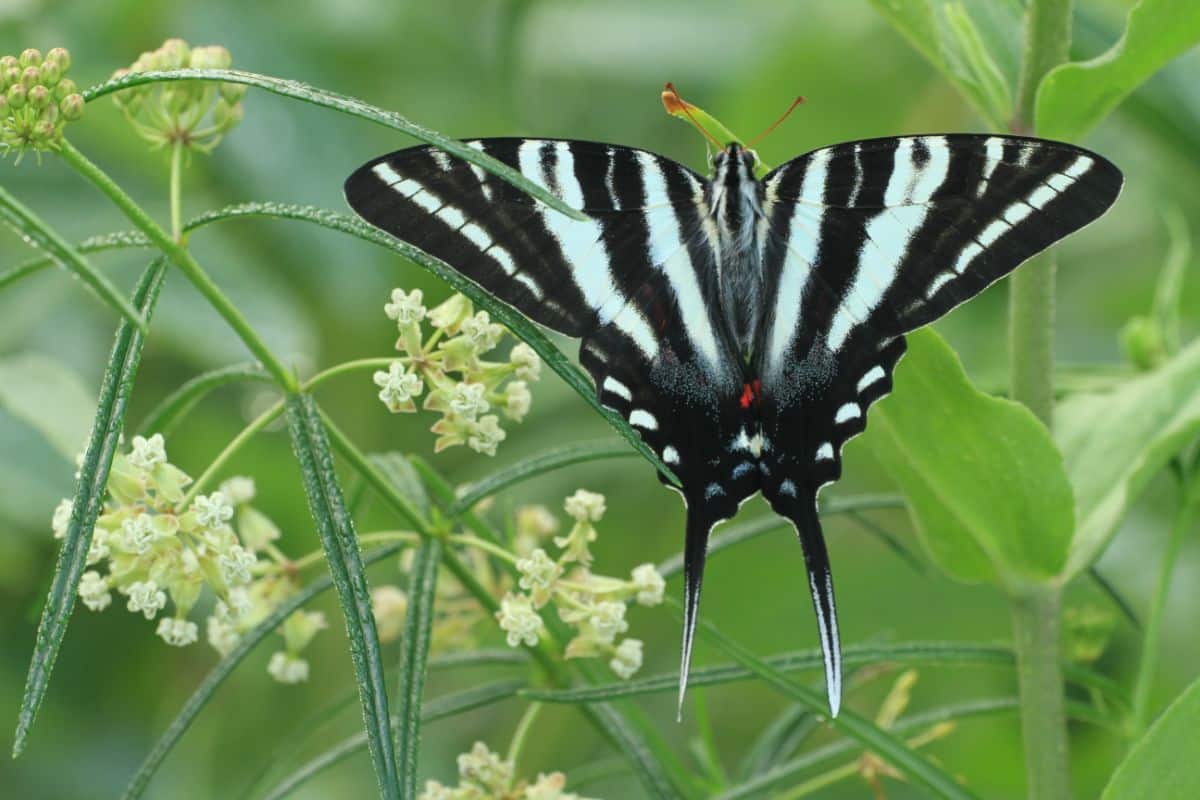
| Milkweed variety: | Whorled milkweed |
| Light requirements: | Full sun to part shade |
| Water requirements: | High to moderate |
| Bloom time: | June to September |
| Growing zone: | Zones 3 to 9 |
For gardeners who prefer a subtler appearance, whorled milkweed is sure to delight. This delicate-looking plant has pale, wispy flowers and needle-like leaves that sprout from the stem in a whorled pattern. Growing between 1 to 2 ½’ tall, this is a shorter milkweed specimen and an ideal plant to sow in the front of garden beds.
Whorled milkweed grows throughout the eastern United States and Canada and is hardy to zone 3. Preferring sandy loam soil, this milkweed can also thrive in richer garden beds, and it can tolerate both full sun and part shade. Whorled milkweed will bloom from April to September, attracting monarchs, swallowtails, and a variety of bees.
6. Purple Milkweed (Asclepiaspurpurascens)
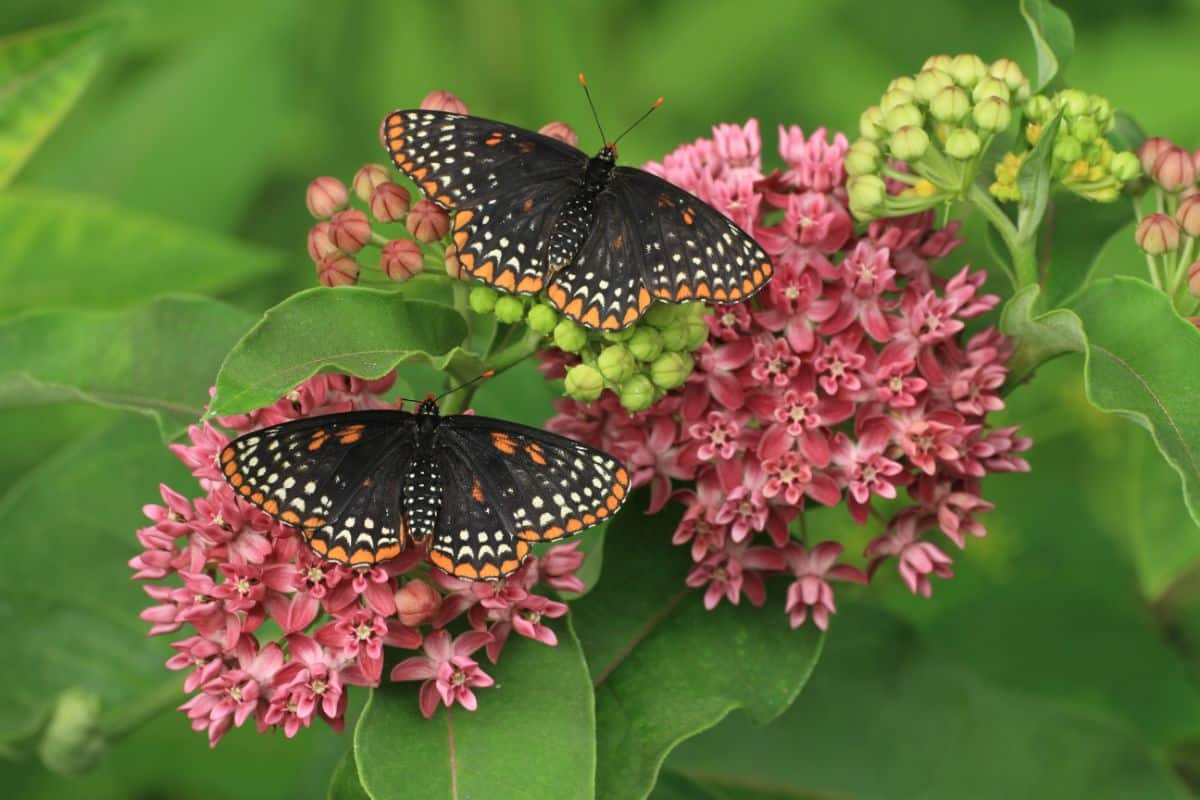
| Milkweed variety: | Purple milkweed |
| Light requirements: | Full sun to part shade |
| Water requirements: | Moderate to low |
| Bloom time: | Mid-summer to early fall |
| Growing zone: | Zones 3 to 9 |
Native to the central and eastern United States, purple milkweed has all the “wow factor” you could want. Vibrant purple flowers will fill up garden beds with lots of colors, and the leaves provide an important food source for monarch caterpillars and other caterpillars too. Growing 2 to 3’ tall, purple milkweed can handle drought, but it will also grow in moderately watered gardens.
Due to overharvesting and other factors, purple milkweed is endangered in some areas, so it’s important to only purchase this plant from reputable sources. Adaptable to shade gardens, purple milkweed can also grow in full sun if you provide it with a bit of extra moisture.
7. Antelope-Horns Milkweed(Asclepias asperula)
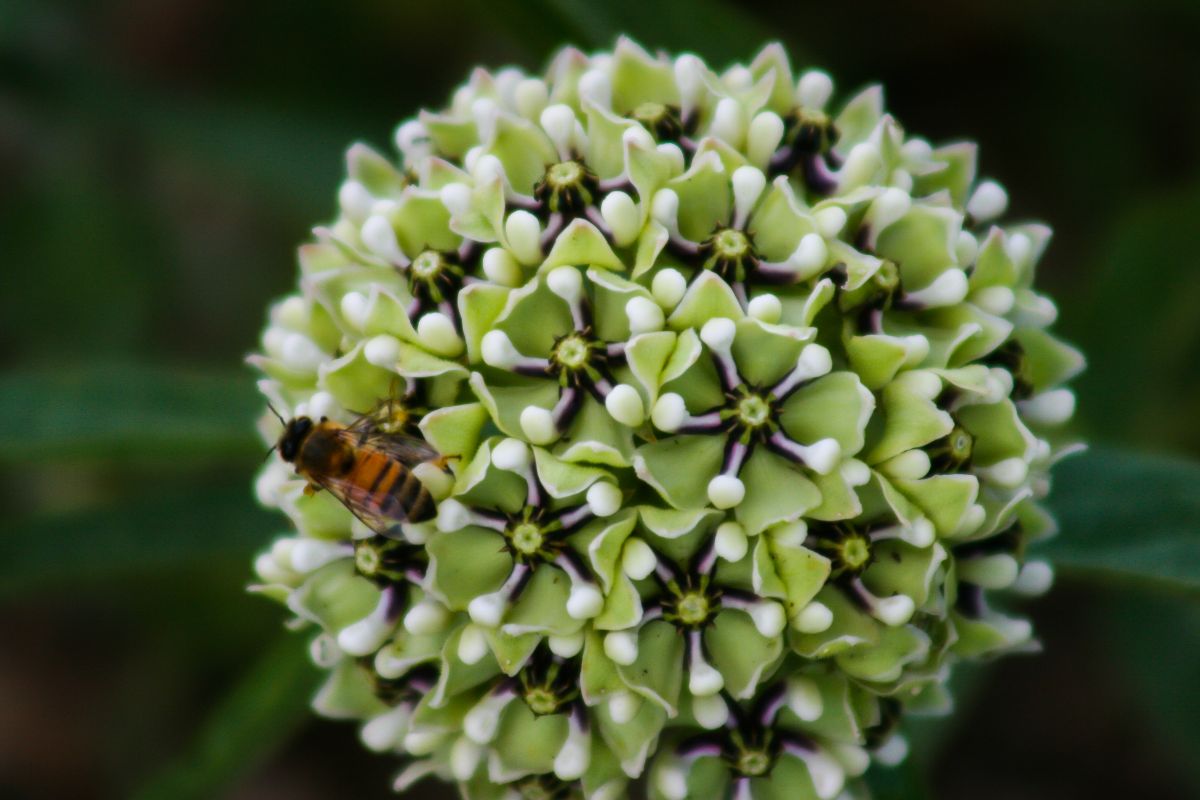
| Milkweed variety: | Antelope-horns milkweed |
| Light requirements: | Full sun |
| Water requirements: | Low |
| Bloom time: | Spring, may bloom infrequently throughout summer and fall |
| Growing zone: | Zones 7 to 9 |
Antelope horn milkweed has a truly out-of-this-world appearance with highly contrasting white, green, and maroon flowers that bloom from April to June. Sometimes found in desert regions, antelope horn milkweed has low watering needs and is native to the southwestern and south-central United States.
In addition to attracting monarchs, queen butterflies love this milkweed variety -- as do many bees and other pollinators. Mature plants grow between 1 to 2’ tall and can have a lower, sprawling appearance when compared to other milkweed types. Antelope horn milkweed isn’t as cold-hardy as some other species and can be grown only in zones 7 to 9.
8. California Milkweed (Asclepias californica)

| Milkweed variety: | California milkweed |
| Light requirements: | Full sun |
| Water requirements: | Moderate to low |
| Bloom time: | June to September |
| Growing zone: | Zones 3 to 11 |
As its name suggests, this milkweed variety is native to California, and it grows as a perennial in zones 3 and up. This hardy plant stays low to the ground and features distinctly wooly leaves that look a bit like lamb’s ear. Those furry leaves help this milkweed variety retain moisture and make it resilient in drought conditions.
California milkweed has spiky lavender to pink flowers that resemble the blooms of showy milkweed. When mature, this milkweed type grows to about 3’ tall and spreads roughly 3’ wide.
9. White Milkweed (Asclepias variegata)
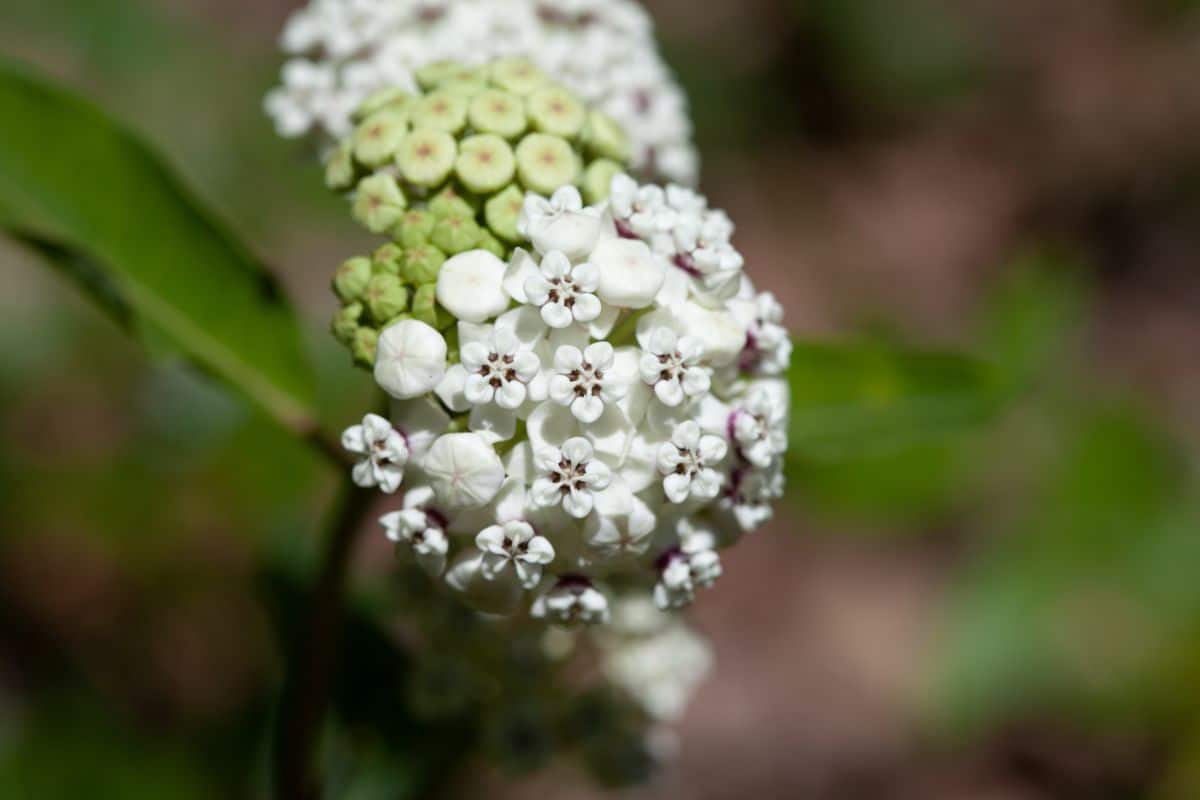
| Milkweed variety: | White milkweed |
| Light requirements: | Full sun to part shade |
| Water requirements: | Moderate |
| Bloom time: | May to June |
| Growing zone: | Zones 4 to 10 |
Also known as red-ring milkweed, white milkweed has bright white blooms with purple centers that lend the flowers an interesting contrast. The flowers are big and ball-shaped and slightly resemble snowballs when in full bloom. In the wild, white milkweed grows along the edges of woodlands and prefers some shade.
Plants grow from 1 to 4’ tall and bloom from May to July. Less cold hardy than some other species, white milkweed can be found in zones 4 through 10. This plant is also endangered in some states, so only purchase it from reputable plant nurseries.
10. Mexican Whorled Milkweed (Asclepias fascicularis)
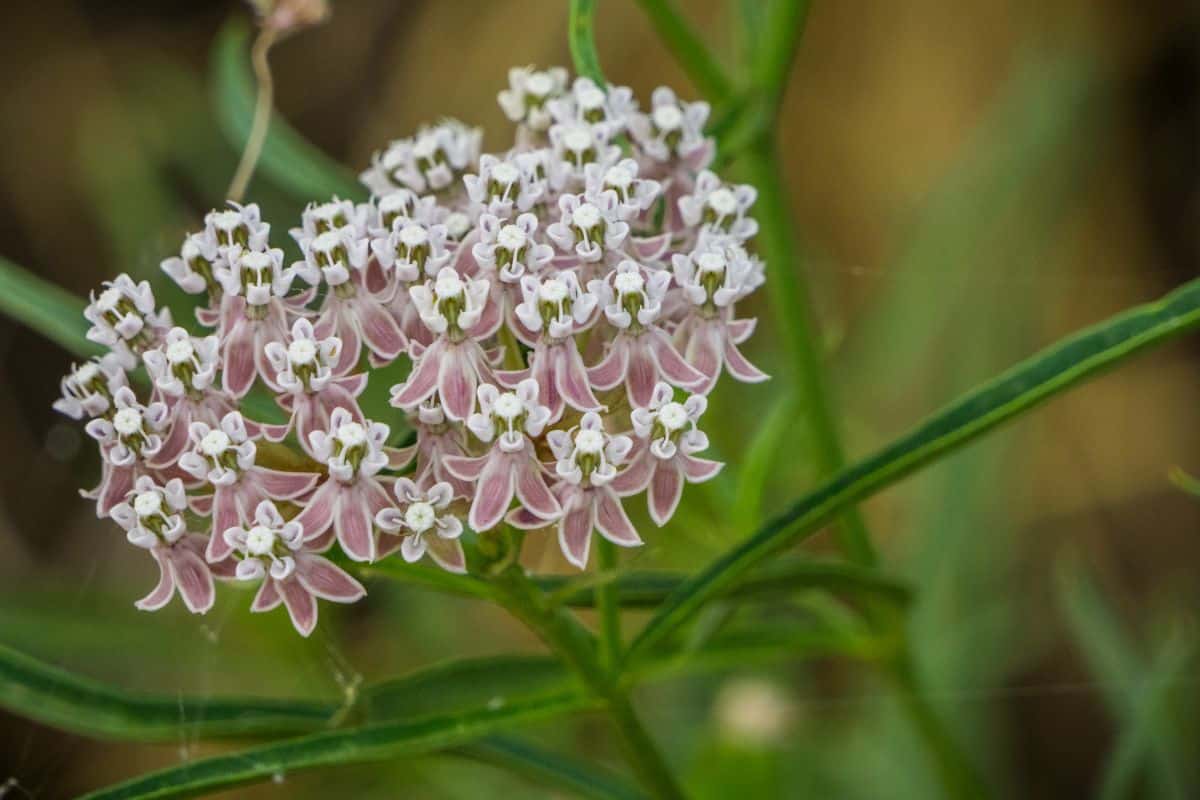
| Milkweed variety: | Mexican whorled milkweed |
| Light requirements: | Full sun |
| Water requirements: | Low |
| Bloom time: | July to September |
| Growing zone: | Zones 6 to 10 |
Also known as narrowleaf milkweed, Mexican whorled milkweed is a delicate-looking plant that is native to the western United States. Hardy from zones 6 to 10, this milkweed variety features finely formed, narrow leaves and subtle clusters of pink to white blooms. Flowering season lasts from June to September, when the plant serves as an important food source for monarchs, as well as tiger moths and many other species.
A relatively adaptable plant, Mexican whorled milkweed is highly drought tolerant, and it can even grow in clay-heavy soils. Just be sure to provide it with plenty of full sun to support flower development.
11. Desert Milkweed (Asclepias erosa)
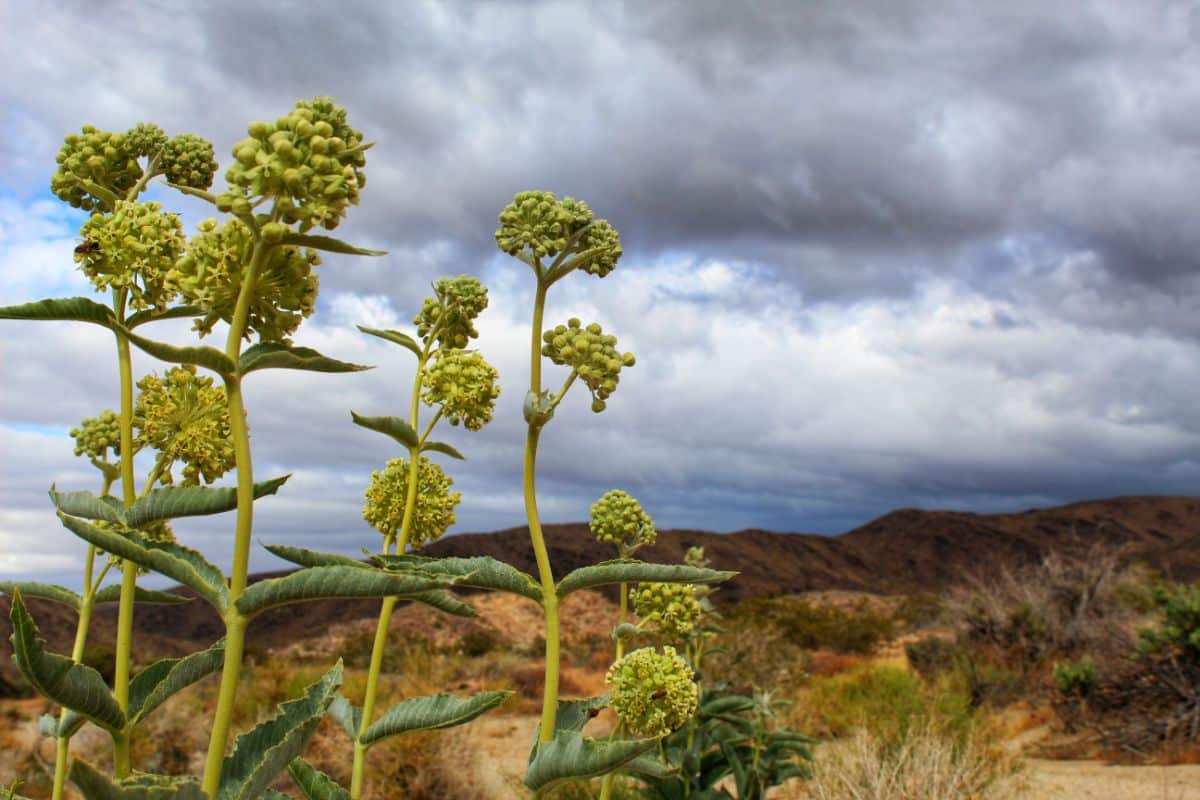
| Milkweed variety: | Desert milkweed |
| Light requirements: | Full sun |
| Water requirements: | Low |
| Bloom time: | June to September |
| Growing zone: | Zones 3 to 11 |
For gardeners in very dry climates, desert milkweed is the milkweed variety of choice. This plant is extremely drought tolerant and doesn’t need to be watered often. It will also grow in sandy soils with minimal nutrient content.
Mature plants reach about 3’ in height and produce ball-shaped clusters of greenish-yellow flowers. Plant leaves have a unique, silvery tone to them, which complements the flowers beautifully. Native to the American southwest, desert milkweed is an important food source for queen butterflies, Clio tiger moths, and monarchs.
12. Poke Milkweed (Asclepias exaltata)
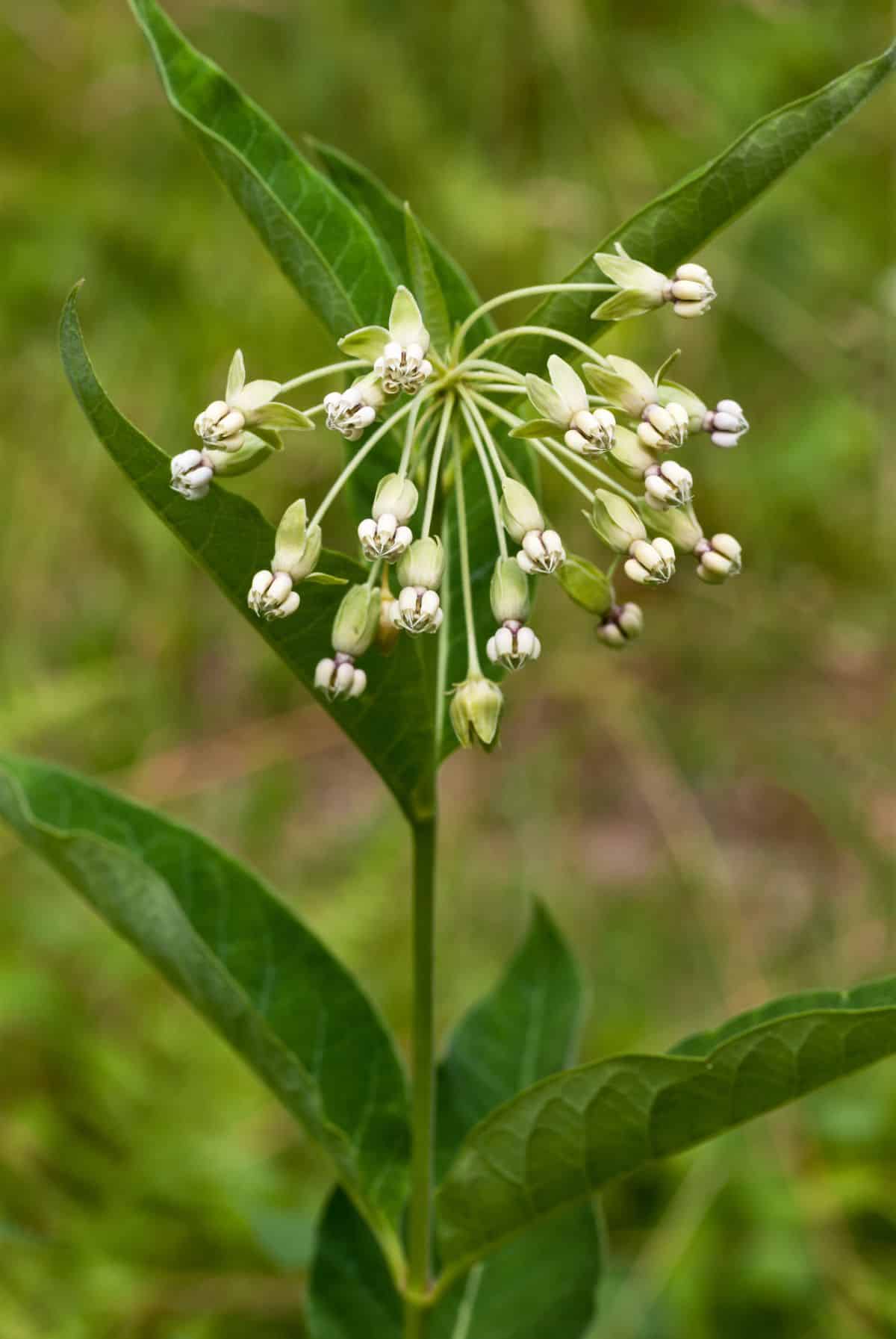
| Milkweed variety: | Poke milkweed |
| Light requirements: | Shade |
| Water requirements: | Moderate |
| Bloom time: | Late spring to early summer |
| Growing zone: | Zones 3 to 7 |
Also known as tall milkweed, poke milkweed is one of the larger milkweed species and can reach 5’ tall. Its name comes from its resemblance to another native plant: pokeweed. Unlike many other milkweed varieties, poke milkweed flowers are loosely formed and have an airy quality to them.
White to lavender flowers bloom from May to August and are a hit with tiger months, as well as monarchs. Poke milkweed prefers part shade and is often found growing along forest margins in the wild. This plant also has moderate watering needs and requires rich soil to grow well.
13. Green Milkweed (Asclepias viridis)
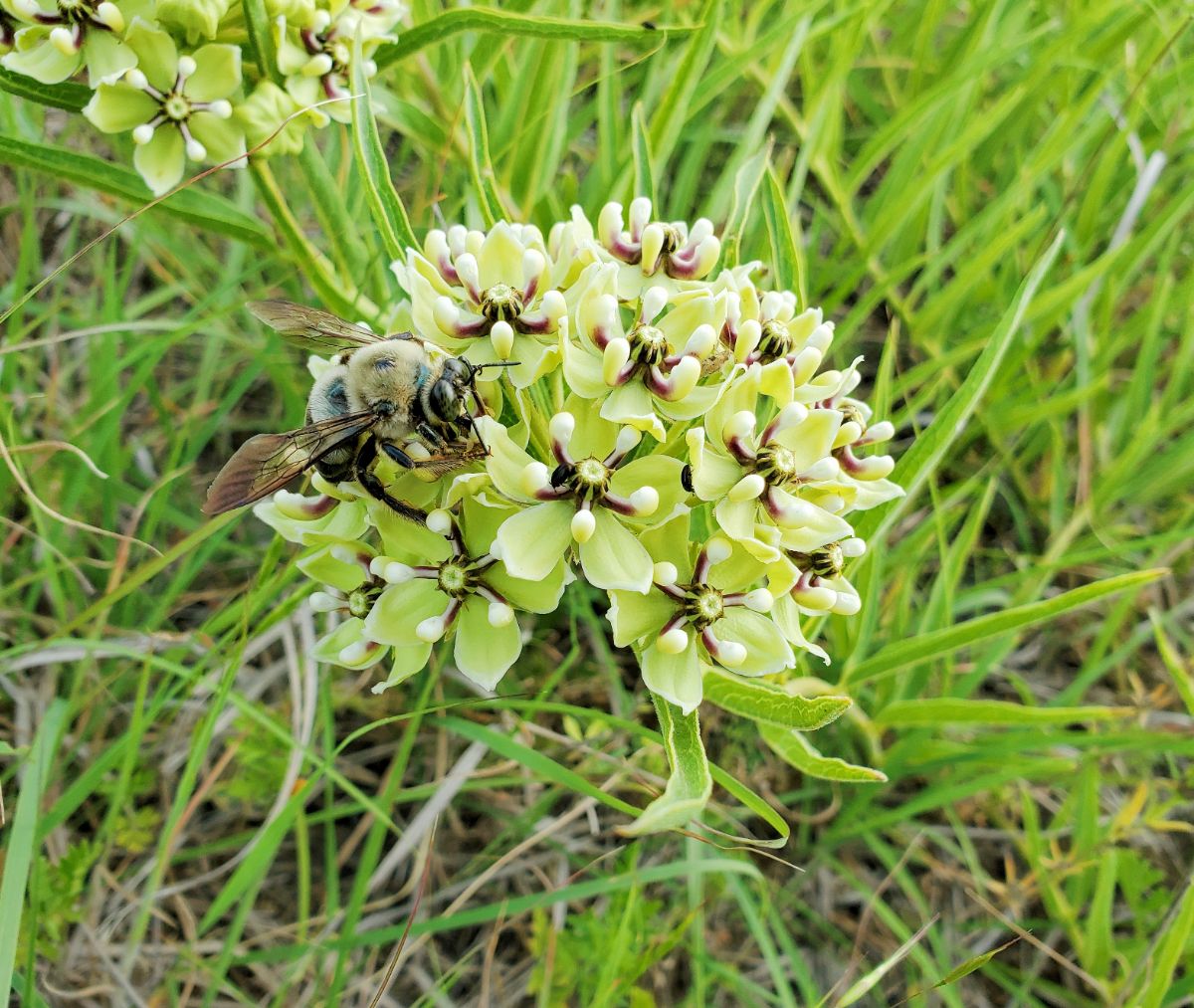
| Milkweed variety: | Green milkweed |
| Light requirements: | Full sun |
| Water requirements: | Low |
| Bloom time: | Late spring to mid-summer |
| Growing zone: | Zones 5 to 9 |
Green milkweed has a similar appearance to antelope horns milkweed and has pale green flowers. This plant is sometimes called “spider milkweed” because crab spiders like to use its flowers as a hunting ground for smaller prey. Hardy to zone 5, green milkweed can be found throughout the eastern and central United States, where it spreads readily by windborne seeds.
Flowers bloom from May to July and form irregular clusters. Mature plants grow about 1 ½ to 2 ½’ tall and prefer garden beds located in full sun. Green milkweed is another drought-tolerant plant, and it can also tolerate a range of soil types.
14. Aquatic Milkweed (Asclepias perennis)
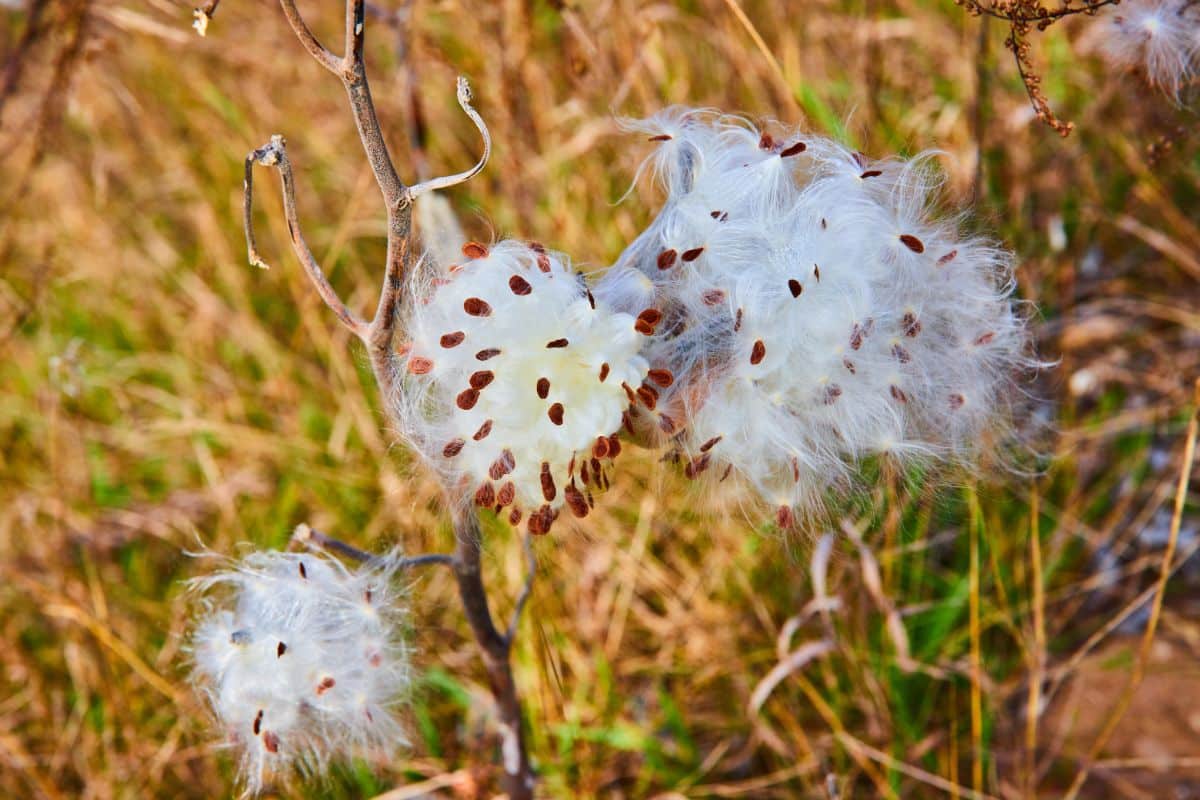
| Milkweed variety: | Aquatic milkweed |
| Light requirements: | Full sun to part shade |
| Water requirements: | High |
| Bloom time: | Late spring to fall |
| Growing zone: | Zones 8 to 10 |
As you might guess, aquatic milkweed is a species that is naturally found in wetland areas. In garden beds, this plant has higher than average watering needs and requires consistently moist or wet soils. It can also be used in rain gardens or as an accent plant around ponds and other water features.
Native to the southeastern United States, aquatic milkweed is not as cold-hardy as most other milkweeds, and it can only be grown in zones 8 to 10. Flowers are delicately made with colors ranging from white to pale pink, and blooms last from May to September. Aquatic milkweed prefers part shade and is an exceptional host plant to many species, including monarchs and tropical queen butterflies.
15. Sandhill Milkweed (Asclepias humistrata)
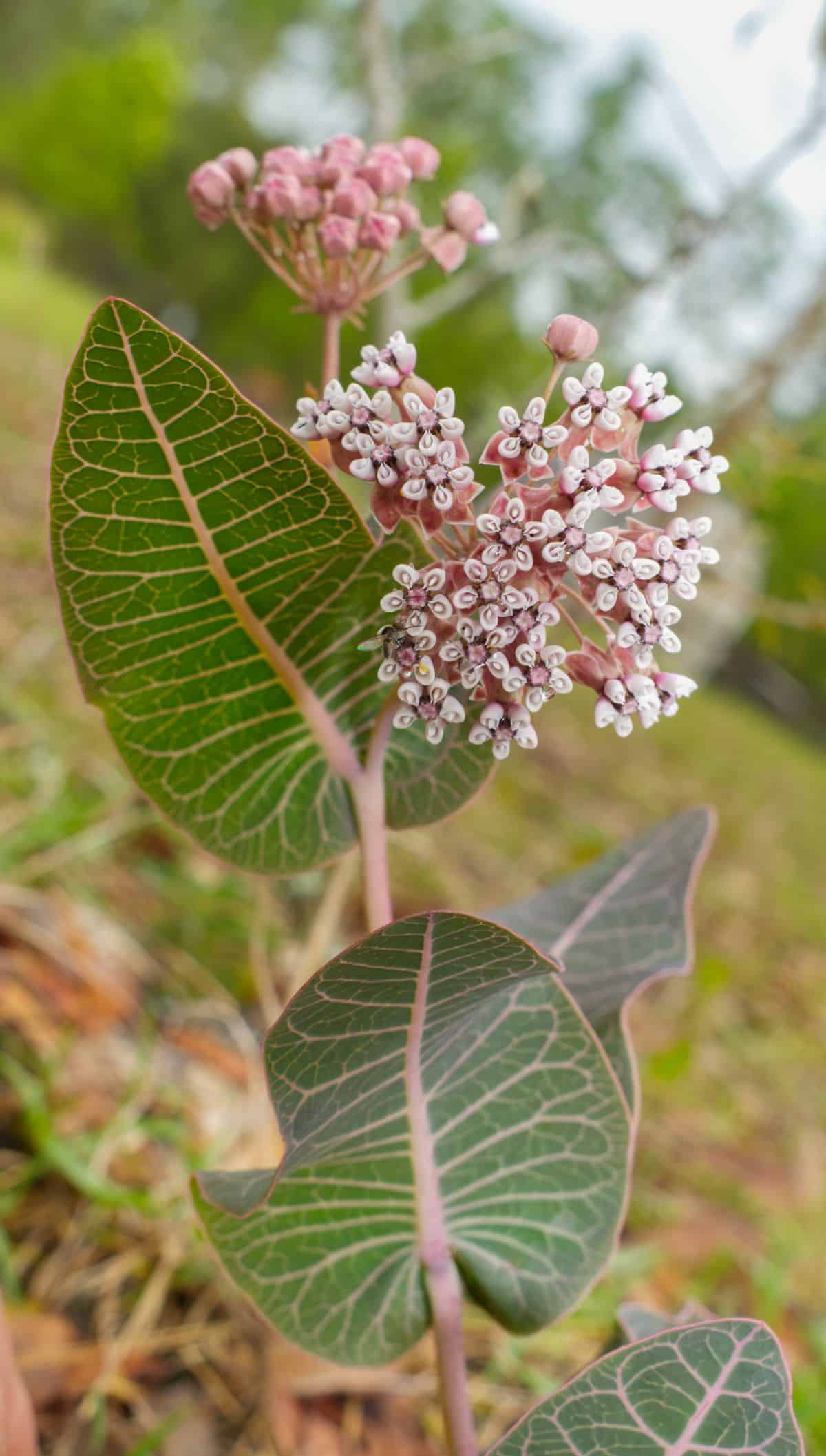
| Milkweed variety: | Sandhill milkweed |
| Light requirements: | Full sun |
| Water requirements: | Moderate |
| Bloom time: | March to June |
| Growing zone: | Zones 8 and up |
Also known as the pinewoods milkweed, sandhill milkweed’s native range is in the southeastern United States, where it grows in habitats dominated by longleaf pines. In gardens, sandhill milkweed will grow best when provided with full sun to dappled shade.
Tolerant of hot and dry climates, sandhill milkweed prefers sandy soil types and can be planted along roadways as it can handle exposed areas. Sandhill milkweed plants grow between 1 and 3’ tall and usually grow upright, although some plants have a more sprawling growth habit. Flowers are pink to purple in color and bloom from March to June.
16. Zizotes Milkweed (Asclepias oenotheroides)
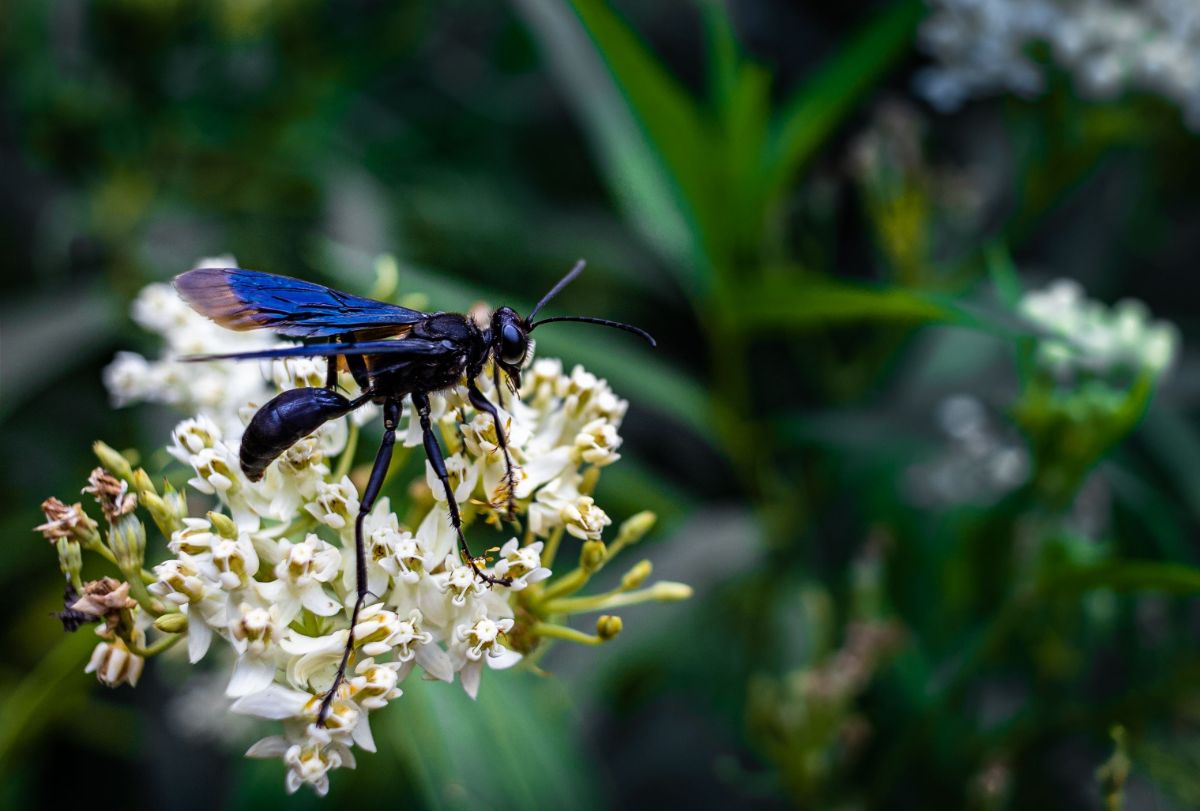
| Milkweed variety: | Zizotes milkweed |
| Light requirements: | Full sun to part shade |
| Water requirements: | Moderate |
| Bloom time: | Late spring to early summer |
| Growing zone: | Zones 7 to 9 |
Zizotes milkweed is native throughout the southern United States, but it is particularly common in Texas. This plant grows between 1 and 2’ tall and has very uniquely shaped flowers, although blooms aren’t as showy as some other species. In addition to monarchs, native bees can often be found foraging on this plant.
A perfect choice for butterfly gardens, Zizotes is a hardy species that doesn’t need much water. However, it does prefer full sun and sandy soils.
Other ways to help monarch butterflies
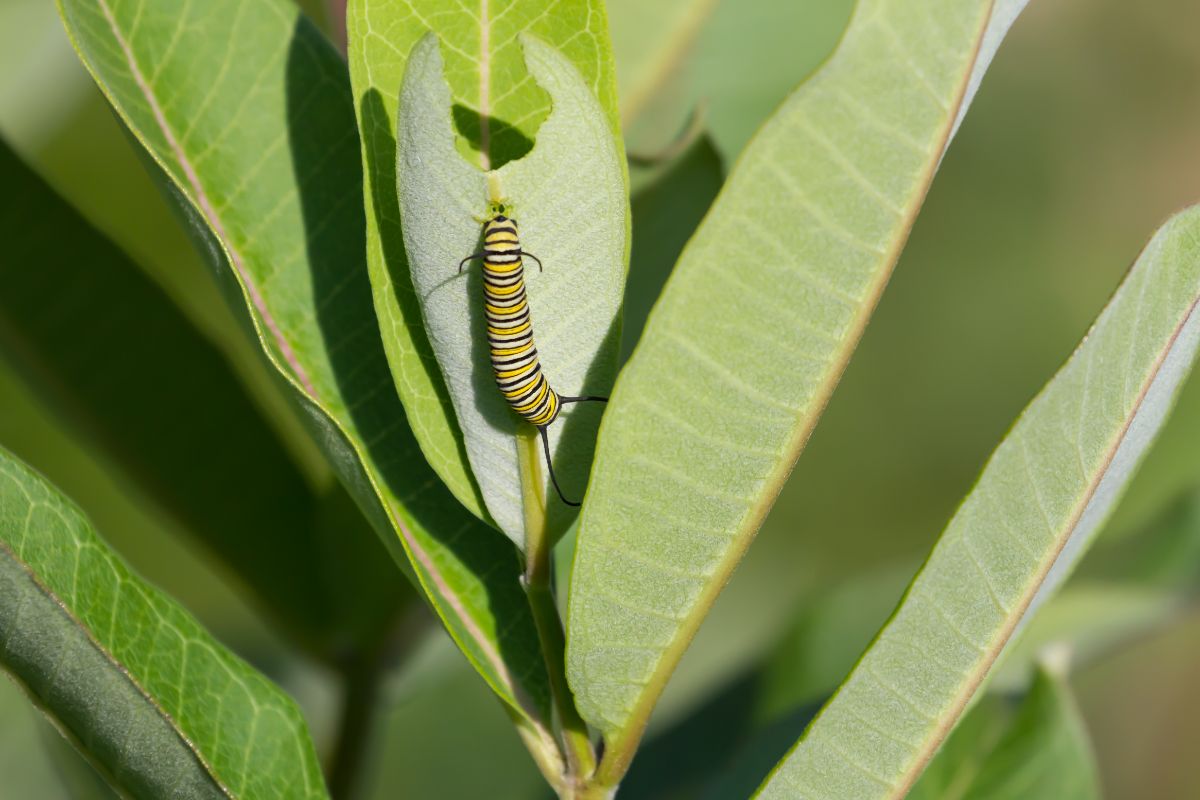
Milkweed plants are an essential food source for developing monarch caterpillars and other pollinators too. However, if you’ve already added some milkweed plants to your garden and you’d like to do even more to help monarchs, there are a few more steps you can take:
Grow other native plants
Monarch caterpillars feed exclusively on milkweed; however, adult monarchs have a more varied diet. To provide for adults, be sure to keep nectar-rich, native wildflowers in your garden too. Plants like bee balm, anise hyssop, phlox, yarrow, and goldenrod are all important food sources for monarchs.
Choose organic when you can
The overuse of chemical pesticides is one of the factors that’s contributing to the decline in monarch populations. For this reason, choosing organic pest control whenever possible is recommended. Floating row covers, crop rotation, choosing plants that are naturally resistant to pests, and using less toxic pest control products can all benefit monarchs.
Add a water feature
Monarchs require food and water to live; however, bird baths are often too deep for monarchs. Instead, a small tray filled with a bit of clean water and pebbles can provide a refreshing sip to monarchs in the heat of summer.
Plan for the entire season
Growing plants that bloom throughout the season will ensure that monarchs will always find something to eat when they visit your garden. That means choosing nectar-rich plants that bloom in spring, summer, and fall. Plants like snowdrops, butterfly bushes, and asters are top choices for year-round color.
Provide shelter
Butterflies usually sleep on sheltered tree branches or on the woody stems of shrubs. Growing larger plants to provide extra shelter can create a habitat to help monarch populations. Butterfly houses may also be welcome additions to your butterfly garden.
Frequently asked questions
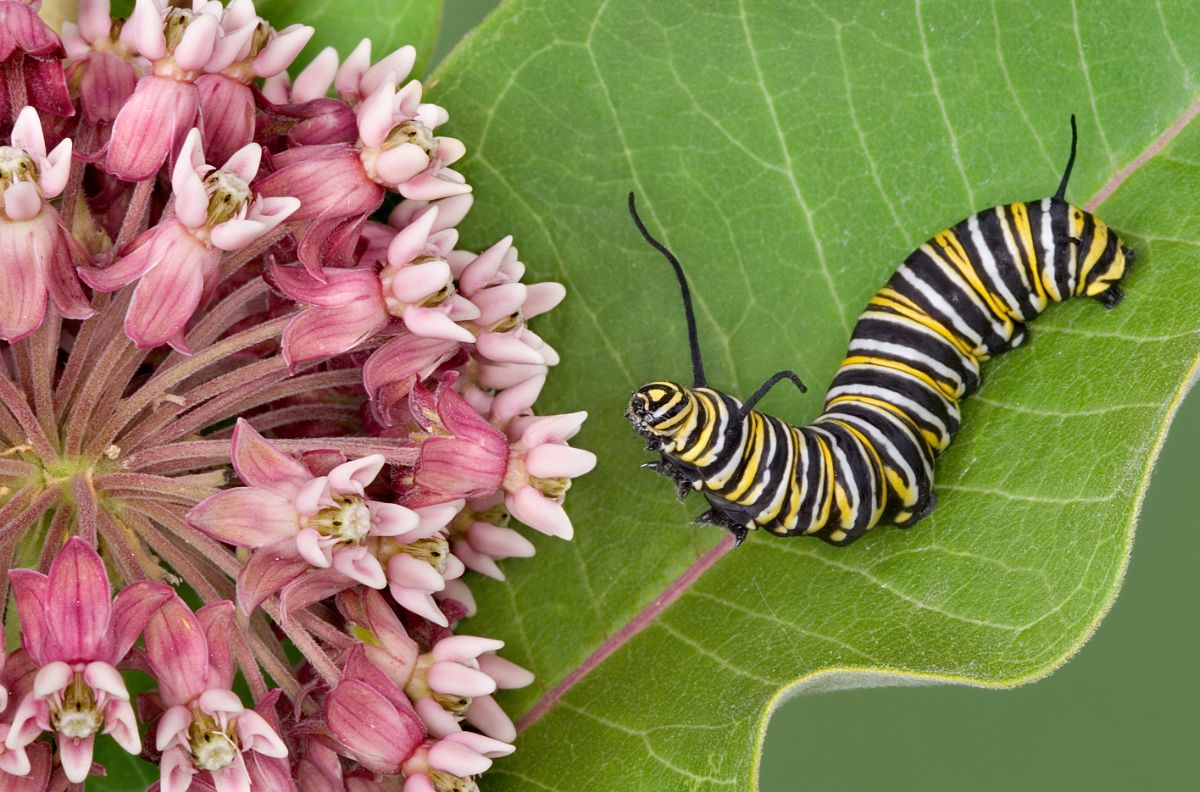
Yes, you can just scatter milkweed seeds on top of the prepared soil. Then cover them up with ¼” of soil and water them until they germinate. While this method is effective, you can boost your germination rates by cold stratifying your seeds prior to planting.
Milkweed can be planted in either fall or spring. Fall planting tends to be easiest as milkweed seeds require a period of cold to jumpstart germination. Spring-planted milkweed seeds should be cold-stratified in your refrigerator prior to planting.
It may take some time for monarchs to discover your milkweed patch, so patience is key. It’s also important to keep your garden as organic as possible to encourage monarchs and other pollinators to take up residence.
Other native wildflowers that are rich in nectar make fine companions for milkweed, as they will provide for adult monarch butterflies. Some good choices include Joe Pye weed, coneflower, Mexican sunflower, bee balm, and goldenrod.
The more milkweed plants you sow, the more likely it is that monarchs will visit your garden. At a minimum, aim to grow at least 6 milkweed plants, which will make the flowers more noticeable to pollinators.
Yes. Grouping plants together makes them easier for monarchs to spot. Sowing plants in groups of 3 or more is recommended, and this planting style also lends a more natural look to your garden.
Summary
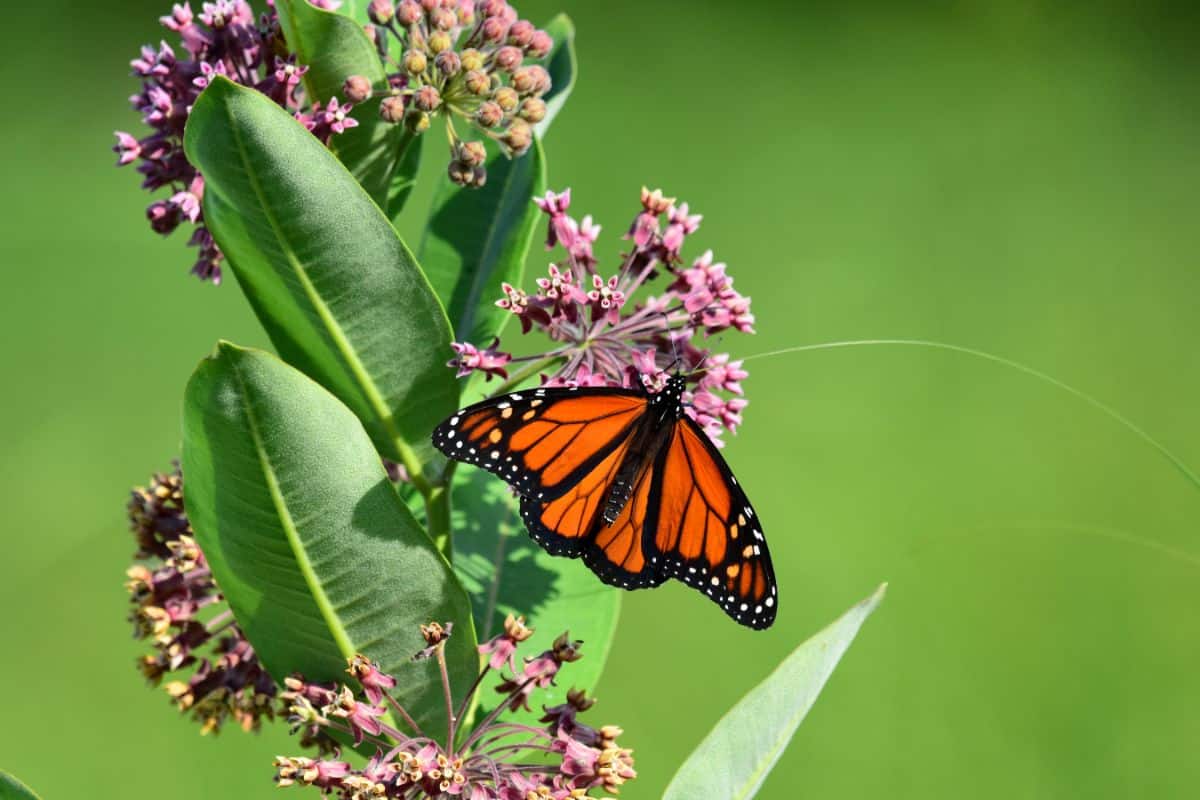
Milkweed isn’t just an attractive plant. It is also one of the most important food sources for monarchs, and it is a critical plant to preserve if we want to help monarchs make a comeback. Sowing milkweed is one big step towards creating a more dynamic landscape and encouraging biodiverse gardens that humans and wildlife can enjoy.
We hope this article on milkweed has inspired you to grow some native plants! If you’d like to learn more about pollinator gardening, check out our guide on building a pollinator habitat here.

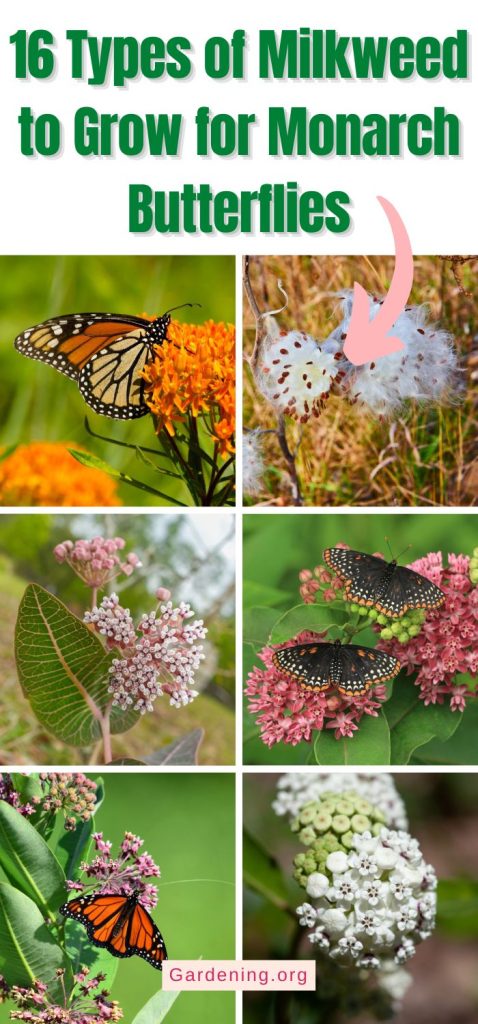
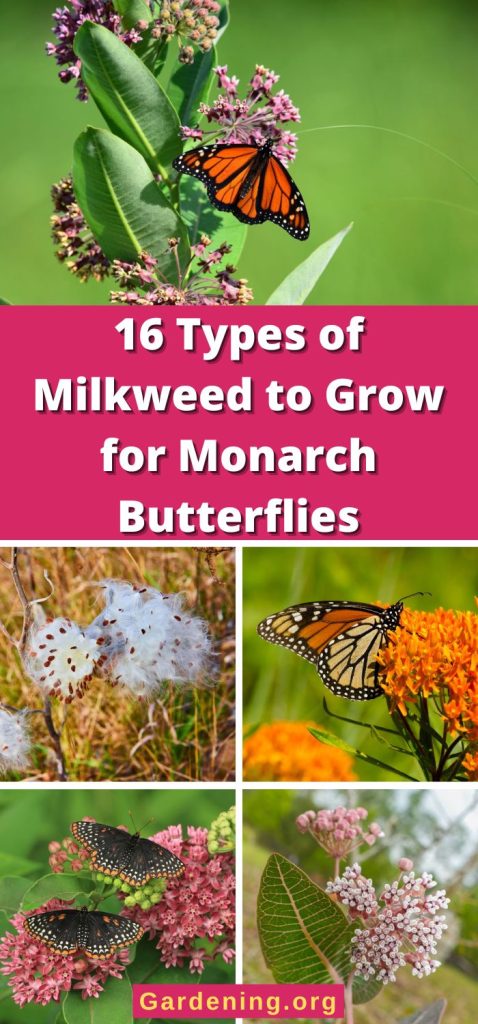

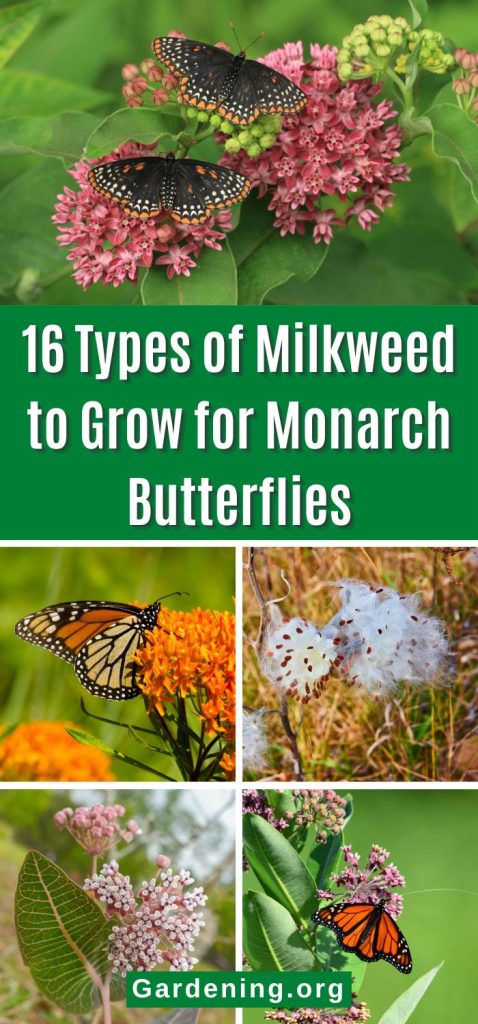

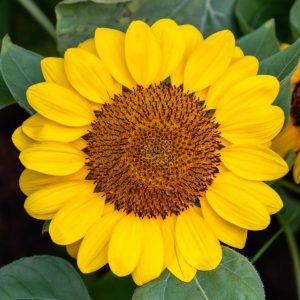

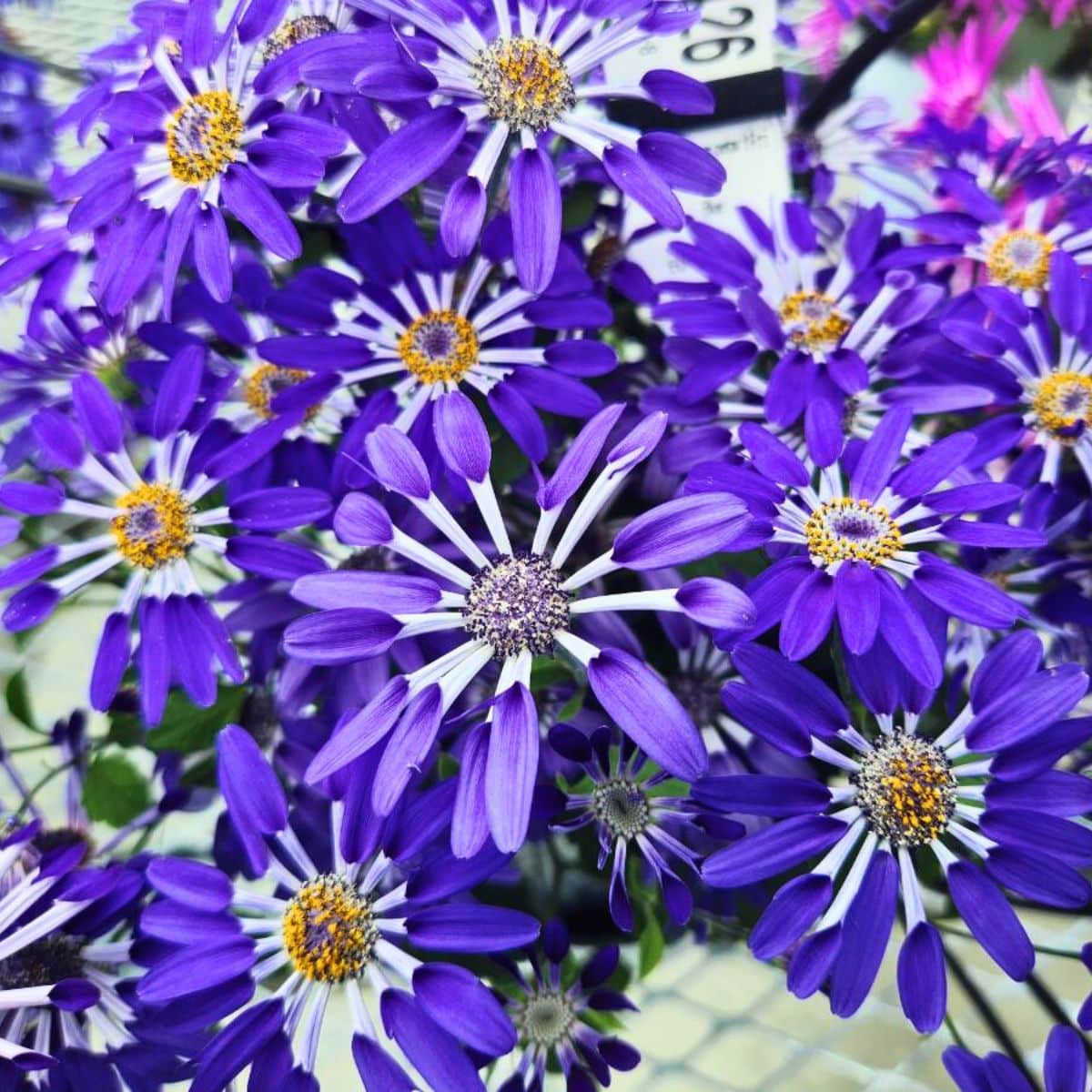
Leave a Reply